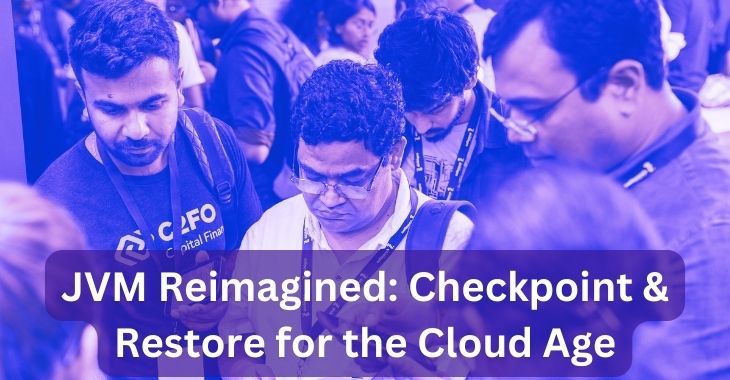
“Once again Saltmarch has knocked it out of the park with interesting speakers, engaging content and challenging ideas. No jetlag fog at all, which counts for how interesting the whole thing was."
Cybersecurity Lead, PwC

The Java Virtual Machine (JVM) is at the heart of numerous applications, driving innovation and efficiency. Yet, one challenge persists: the need for faster JVM startup times. Enter the checkpoint and restore technique. By pausing and serializing an application (checkpointing) and then later loading and resuming it (restoring), this method promises impressive startup enhancements with minimal application changes.
"The latency cost is proportional to the JVM startup time and so every time you spin up new instances, you start the JVM and so on. This is why JVM startup is very important and minimizing it can save costs." - Tobi Ajila, Developer on the OpenJ9 team at IBM.
Based on Tobi's talk, this article dives into the groundbreaking approach of using checkpoint and restore to tackle this challenge head-on, while also shedding light on traditional techniques that have set the stage.
The Imperative for Swift JVM Startup
The last decade has witnessed a monumental shift towards deploying applications in cloud environments, including giants like AWS and Azure. This paradigm allows developers to immerse themselves in coding, relegating infrastructure management to cloud providers. However, the pricing model of these platforms hinges predominantly on compute resources, specifically CPU and RAM consumption.
Applications often grapple with fluctuating demand. Peak times necessitate augmented resources, while off-peak durations are more lenient. Innovations like k-native and open fast have revolutionized the ease of scaling applications based on demand. Yet, to truly harness the advantages of such scalability, especially in a 'scale to zero' framework, achieving JVM startup times under a second becomes paramount. This rapid startup is indispensable for latency-sensitive platforms, such as e-commerce sites and streaming services.
Existing Techniques for Faster Startup
Over the years, developers have leaned on several techniques to boost JVM startup times. One such method is class metadata caching. This technique revolves around preserving static segments of the class, encompassing byte codes and string literals, and repurposing them in subsequent runs. While this method has proven its mettle, it's not the sole contender.
Static compilation, exemplified by tools like Native Image, has also entered the fray. This strategy promises lightning-fast startup times coupled with a diminished application footprint. However, it's not devoid of hurdles, especially when preserving Java's intrinsic dynamic nature.
Enter Checkpoint & Restore
Amidst these techniques, checkpoint and restore emerges as a promising contender, striking a balance between the old and the new. Facilitated by tools like CRIU (Checkpoint/Restore In Userspace), the concept is straightforward yet revolutionary: capture a snapshot of the application post-significant initialization but pre-full readiness. This snapshot, once restored, bypasses the startup phase in its entirety.
CRIU accomplishes this feat by recording the application's state, spanning memory, register values, and even networking nuances, and archiving it into a file. During restoration, it mirrors the system calls that birthed the original state, effectively picking up the application from its last known point. IBM's OpenJ9 has seamlessly integrated CRIU support, empowering developers to ascertain CRIU's availability on their systems and subsequently leverage it for expedited startup times.
Challenges in the Checkpoint & Restore Paradigm
Despite its potential, the checkpoint and restore methodology isn't devoid of challenges:
The pursuit of swift JVM startup times is pivotal in our contemporary cloud-centric landscape. While checkpoint and restore, championed by tools like CRIU, present a promising avenue, it's imperative to remain cognizant of its inherent challenges. As teams like OpenJ9 persistently refine this methodology, the JVM space remains a thrilling domain for enthusiasts and professionals alike. For those of you intrigued by JVM performance, especially in cloud settings, this talk by Toby Ajila at the JVM Languages Summit 2023 is a must watch.
Have questions or comments about this article? Reach out to us here.
Banner Image Credits: Attendees at Great International Developer Summit

“Once again Saltmarch has knocked it out of the park with interesting speakers, engaging content and challenging ideas. No jetlag fog at all, which counts for how interesting the whole thing was."
Cybersecurity Lead, PwC

“Very much looking forward to next year. I will be keeping my eye out for the date so I can make sure I lock it in my calendar."
Software Engineering Specialist, Intuit

“Best conference I have ever been to with lots of insights and information on next generation technologies and those that are the need of the hour."
Software Architect, GroupOn

“Happy to meet everyone who came from near and far. Glad to know you've discovered some great lessons here, and glad you joined us for all the discoveries great and small."
Web Architect & Principal Engineer, Scott Davis

“Wonderful set of conferences, well organized, fantastic speakers, and an amazingly interactive set of audience. Thanks for having me at the events!"
Founder of Agile Developer Inc., Dr. Venkat Subramaniam

“What a buzz! The events have been instrumental in bringing the whole software community together. There has been something for everyone from developers to architects to business to vendors. Thanks everyone!"
Voltaire Yap, Global Events Manager, Oracle Corp.